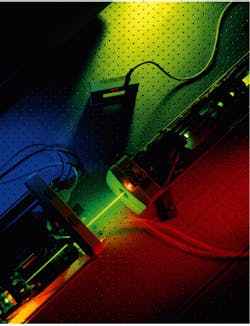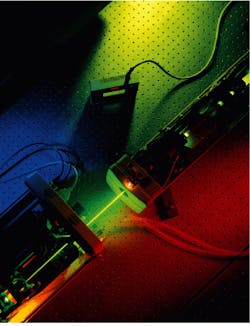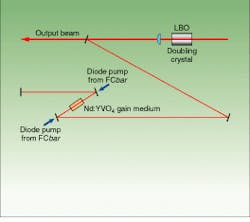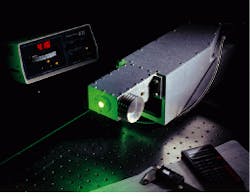DPSS lasers challenge water-cooled ion lasers
DPSS lasers challenge water-cooled ion lasers
Recent advances in diode-pumped solid-state lasers provide more output power at visible and UV wavelengths.
William L. Nighan Jr. and Bruce Craig
The market for high-power continuous-wave (CW) visible and ultraviolet (UV) lasers is about $75 million annually (see Laser Focus World, January 1996, p. 50). Applications include entertainment, scientific laser pumping, medicine, reprographics, stereolithog raphy, and compact-disk mastering, among others. The size and diversity of this market have attracted extensive product offerings from many laser producers.
Until recently, "high-power CW visible and UV lasers" were synonymous with "gas and ion lasers." Unfortunately, the wall-plug efficiency of a state-of-the-art, multiple-watt ion laser is less than 0.05%, which means "gas and ion lasers" also translate to high utility and water-cooling costs, as well as the large size and weight typical of high-power gas lasers. Although these unavoidable attributes have been tolerated in applications where high-power (more than 1 W), short-wavelength (less than 675 nm), high-beam-quality laser light is an absolute requirement, many more applications should open up if new solid-state devices can fulfill expectations.
The solid-state promise
An intracavity-doubled, diode-array-pumped solid-state laser producing 10 mW of green light was first demonstrated more than ten years ago.1 This experiment suggested that solid-state alternatives to ion lasers--but with wall-plug efficiencies at least 20 times higher--would someday be possible. In the past few years several diode-pumped solid-state (DPSS) green sources with output powers ranging from 10 to 400 mW have been introduced, with products offered by Coherent (Santa Clara, CA) and Uniphase (San Jose, CA), for example. Performance of these DPSS lasers approaches that of the low-power, air-cooled argon-ion lasers typically used in graphics and diagnostic-medical applications.
Although low-power DPSS lasers have made market inroads for applications in which the cooling-fan vibration or high heat load associated with ion lasers is undesirable--or at power levels slightly above those provided by 110-V air-cooled ion lasers--the mature air-cooled ion-laser market has been difficult for DPSS lasers to penetrate because the price-to-performance ratios of a low-power ion laser are hard to beat. A robust solid-state technology will, however, make a more significant impact at higher power levels. Lasers with outputs greater than 1 W could be incorporated into products and applications in which inclusion of a large-frame ion laser is impossible.
Visible-wavelength high-power DPSS lasers have only recently become available. Lightwave Electronics (Mountain View, CA) offers a 2-W, 532-nm device [This laser received a 1996 Laser Focus World Commercial Technology Achievement Award; see Laser Focus World, Jan. 1996. p. 110--Ed.], and at Spectra-Physics Lasers (SPL) we recently introduced a 5-W, 532-nm system (see photo on p. 63 and on cover).2 One obvious application of such devices is pumping scientific Ti:sapphire lasers. Others include retinal photocoagulation and laser light shows.
While ion-laser-replacement applications are obvious opportunities, more-significant long-term potential for high-power DPSS lasers involves integrating them into new OEM and industrial applications that need high power but not the disadvantages of ion lasers. Examples already exist at IR wavelengths; 5- to 10-W DPSS lasers with 1064-nm output are used in graphics applications that could not tolerate a large, water-cooled lamp-pumped laser.3
Current high-power green DPSS laser products offer 110-V operation, acceptable lifetimes, and laser heads light enough to be transported by one person. These lasers can meet or exceed lifetime expectations for high-power ion-laser plasma tubes. As diode-bar technology matures, it may be possible to extend lifetimes far beyond those of ion-laser plasma tubes.
Pulsed and CW opportunities
The green output of ion lasers is used in many applications, so the 523- to 532-nm second-harmonic wavelengths of diode-pumped Nd:YLF, Nd:YAG, or Nd:YVO4 are important for the high-power, CW-ion-laser replacement opportunities. To dislodge ion lasers, a solid-state technology must meet and exceed typical ion-laser specifications. These include high CW output power, nearly perfect beam quality, and excellent beam-pointing stability. In addition the laser must exhibit excellent amplitude stability with low noise and have an acceptable initial cost as well as tolerable operating and maintenance costs. Field replacement of the pump diodes must also be possible without the need for laser realignment.
The first three conditions, while challenging, are standard laser requirements. The last four, however, raise issues unique to DPSS lasers. The low-noise requirement is usually regarded as the hardest to meet because intra cavity-doubled lasers are thought to be inherently unstable.4 The initial cost is also an issue because the laser diodes and crystals required to build high-power visible lasers are relatively expensive. The operating- and maintenance-cost requirement can only be met by a highly efficient design that maximizes diode lifetime for a given green or blue output power; with an efficient design, fewer diode pump sources are required to meet a given output-power requirement.
At SPL we have chosen to meet these challenges by end-pumping the solid-state crystal with field-replaceable diode bars that are fiber-coupled to the laser head, thereby leaving the head undisturbed during diode replacement.5 Pump light is transmitted through the fiber bundles with 85% to 90% efficiency. This design has been used to end-pump several different OEM laser heads to high power at very high efficiency; the conversion efficiency of the pump light to TEM00 laser light is as high as 53% at 1064 nm--the highest ever for a laser above 10 W.
With refined end-pumping, efficiencies of more than 30% have been achieved for continuous 532-nm operation, and 6% efficiency has been achieved for conversion of diode light to pulsed 355-nm output with a pulse-repetition-frequency (PRF) of 20 kHz--again record efficiencies for nearly diffraction-limited beams.6 End-pumping, while challenging at high power, has proven to be about twice as efficient as side-pumping. High efficiency is critical for a diode-pumped product; it allows derating of diodes to increase their lifetimes and also enables fewer pump diodes to be used for a given diode-pumped laser performance.
Certain other high-power, short-wavelength applications can be addressed with Q-switched-laser pulses at high PRFs. This has some advantages because the pulsed peak power can be enough for efficient, straightforward extracavity frequency conversion. Typically, a high-power ion-laser application that can be addressed by a doubled or tripled Q-switched DPSS laser requires a high PRF because the solid-state laser needs to appear nominally continuous (quasi-CW) in the application.
The requirement might vary from 5 to 100 kHz, depending upon the writing speed and material interaction. Thus in rapid prototyping, for example, solid-state-laser-based stereolithography was recently reported by 3D Systems Inc. (Valencia, CA). A frequency-tripled, high-repetition-rate solid-state source laser was used to expose UV-sensitive resins instead of the 351-nm argon-ion laser typically used in this application.7 Other high-repetition-rate systems require only doubling to generate green output; an example is regenerative amplifier pumping for scientific customers.
Stable solid-state CW green lasers
Free-running intracavity-doubled DPSS lasers typically provide chaotic output with large amplitude fluctuations that render the laser output useless for most applications; this "green problem" was described nearly 10 years ago.4 Part of the cause of the instability arises from nonlinear coupling of axial modes via sum-frequency generation in the laser cavity. Although various techniques have been developed to address the problem, until very recently, none had yet appeared in a product that provides more than 2 W output.
One approach to the problem is single-frequency operation--available in a 400-mW laser from Coherent--while another, implemented by Sony (Tokyo, Japan) in 5-10 mW devices, uses dual orthogonal (and therefore uncoupled) axial modes.8,9 Both techniques have been demonstrated at higher powers, but they are sensitive to environmental perturbations or pump-diode degradation. The demands on these lasers are severe; in a graphics application, a single mode-hop can destroy the exposure of an entire photographic plate.
We have chosen a different approach to solve the "green problem." Based on the recently patented highly multiaxial mode technique for intracavity doubling, our approach deviates significantly from single-frequency or dual-frequency techniques.10 The cavity incorporates a large number of axial modes (typically about a 100) in a balance with other laser parameters; the result is a robust, highly stable configuration that allows construction of high-power CW intracavity-doubled lasers with very stable output (see Laser Focus World, Jan. 1996, p. 16). The noise levels of 0.05% RMS (to 2 MHz), for example, are five times lower than those of a typical small-frame ion laser at the multiple-watt output level. Peak-to-peak amplitude noise is typically 10 times lower than that of a typical ion laser. Similar effects have been observed in lamp-pumped lasers.11
The SPL 5-W, 532-nm Millennia laser combines the highly multiaxial mode-doubling technique with fiber-coupled-diode-bar end-pumping technology. An important step in this laser`s development was application of fiber-coupled-diode-bar technology to pump a 1064-nm Nd:YVO4 laser to nearly 14 W TEM00 at 53% optical efficiency. This is the highest-reported efficiency with a DPSS laser at this power level and the highest output power ever achieved with Nd:YVO4. The laser output is TEM00 in spite of large, pump-induced, nonparabolic phase aberrations in the thermal lenses generated by the fiber-coupled pump sources. This technique was extended to a high-power intracavity-doubled laser. Intracavity doubling is accomplished with a noncritically phase-matched lithium triborate (LBO) crystal, housed in an oven at one end of the resonator cavity (see Fig. 1).
The Millennia has generated greater than 6 W output at 532 nm in a continuous TEM00 beam with RMS noise <0.05% and optical-to-optical efficiency >30%--the highest reported for power greater than 1 W (see Fig. 2). The diode sources are operated at a conservative total power of approximately 20 W at the outputs of the fiber bundles. Although up to 36 W are available (two 20-W bars at 90% fiber-coupling efficiency), we operate the diodes well below their maximum ratings to extend lifetimes. This is currently required with 20-W bars from all laser-diode manufacturers; many thousands of hours of warranty lifetime are possible only with operation below 20 W. This is the advantage of a highly efficient end-pumped design; less diode pump power is required to generate a desired output from the diode-pumped laser.
High-repetition-rate green and UV sources
A high-repetition-rate Q-switched, frequency-doubled Nd:YAG laser has been developed for an industrial application (see Fig. 3). In this case the output is >4 W at 532 nm with a PRF of 10 kHz and doubling efficiency of 65%. The doubling crystal in this system is noncritically phase-matched LBO, which maintains the nearly diffraction-limited beam quality of the Nd:YAG laser. This laser system is completely air-cooled, which is made possible by fiber-coupling the diodes and the high optical efficiency. Thermal management of the diodes is handled in the power supply, and only 15 W of waste heat must be dissipated from the laser crystal.
For higher repetition rates (20 kHz and up) harmonic generation of Q-switched Nd:YVO4 lasers is ideal. With this material, short (~10 ns) Q-switched pulses are delivered with high energy (~200 µJ). The short upper-state lifetime of this material produces optimal harmonic average power generation at the relatively high PRF of 20 kHz. As an example, a system generating 500 mW of the third harmonic (355 nm) of a Q-switched Nd:YVO4 laser with a PRF of 20 kHz can substitute for a CW 351-nm large-frame argon-ion laser. The IR-to-355-nm conversion efficiency is more than 20%. The DPSS system uses 110-V power and no cooling water, in contrast to the needs of the ion laser.
Shorter-wavelength UV can also be produced at high repetition rates. More than 1 W of 266-nm output has been generated as the fourth harmonic of a Q-switched Nd:YVO4 laser, and 0.4 W of fifth harmonic has been generated by Sony researchers with a Q-switched Nd:YAG laser at 7 kHz.12,13
The future
Solid-state generation of truly continuous UV laser light by resonant harmonic generation has been demonstrated as an avenue for conversion of CW green into CW 266 nm at powers higher than 1 W and 355 nm at >100 mW.14,15 While these demonstrations by Sony researchers are impressive, it is unclear if this relatively complex resonant harmonic technology can be incorporated into a high-power product sufficiently robust for industrial applications.
Although green sources based on frequency-doubling of 1-µm lasers have been the first high-power products, neodymium-based sources, such as diode-pumped Nd:YLF, Nd:YAG, and Nd:YVO4 lasers, can also be extended to blue and deep red by frequency-doubling of transitions near 946 nm and 1.32 µm, respectively. It will be some time, however, before these solid-state lasers will be available at multiwatt CW outputs.
While some applications will certainly benefit from the performance advantages of efficient green, blue, or red solid-state lasers, certain aspects of ion-laser performance will always be difficult to match. One of them is multiple-wavelength, or white-light operation, at the watt level, and another is high-power CW ultraviolet generation. Still another is short-wavelength, high-power red generation. The development of ion lasers over the past 30 years has provided a broad range of products in these wavelength ranges and at high power. Thus, it will take many years before solid-state lasers completely replace ion lasers; the technologies will complement one another for the foreseeable future. n
REFERENCES
1. T. M. Baer and M. K. Keirstead, CLEO 1985 Technical Digest, paper ThZ1, OSA, Washington, DC.
2. W. L. Nighan Jr. and J. Cole, Advanced Solid State Lasers Conference, paper PD4 (OSA, San Francisco, CA; 1996).
3. S. B. Hutchison et al., Proc. SPIE 1865, 61 (1993).
4. T. M. Baer, JOSA B, 3, 1175 (1986).
5. W. L. Nighan Jr., D. Dudley, and M. S. Keirstead, CLEO 1995 Technical Digest, paper CMD5, OSA, Washington, DC.
6. A. B. Petersen and W. L. Nighan Jr., CLEO 1995 Technical Digest, paper CWG2, OSA, Washington, DC.
7. J. Partanen, paper presented at Photonics West 1996.
8. J. L. Nightingale and J. K. Johnson, CLEO 1994 Technical Digest, paper PD6, OSA, Washington, DC.
9. M. Oka and S. Kubota, Opt. Lett. 13, 805 (1988).
10. W. L. Nighan and J. Cole, US Patent No. 5,446,749.
11. V. Magni et al., Opt. Lett. 18, 2111 (1993).
12. A. B. Petersen et al., paper to be presented at CLEO `96, Anaheim, CA.
13. W. Wiechmann et al., CLEO 1995 Technical Digest, paper CPD19, OSA, Washington, DC.
14. M. Oka and S. Kubota, CLEO 1995 Technical Digest, paper CTuM1, OSA, Washington, DC.
15. Y. Kaneda et al., CLEO 1995 Technical Digest, paper CPD22, OSA, Washington, DC.
Diode-pumped, solid-state 5-W visible output laser pumps a modelocked Ti:sapphire laser producing 1 W of ultrastable output. The efficiency, low noise, and beam quality of the solid-state green-emitting laser make it an excellent pump source.
FIGURE 1. Millennia cavity is based on a Nd:YVO4 laser head first developed for 1064-nm OEM applications. The output coupler of the OEM laser has been removed, leaving the Nd:YVO4 head positioned as one end of a standing-wave resonator about 1 m long and designed to support 100 axial modes. Mirror curvatures were chosen to preserve an optimal TEM00 mode size in the laser crystal and in the LBO doubling crystal.
FIGURE 2. More than 6 W of green output is obtained from an intracavity-doubled diode-pumped laser with 20-W total diode pump power; this represents an efficiency of 30% (left). Comparison of rms noise characteristics shows the significantly better performance of the diode-pumped solid-state Millennia relative to a typical water-cooled ion laser (right).
FIGURE 3. Q-switched, frequency-doubled diode-pumped Nd:YAG laser developed for industrial applications produces more than 4 W of output at 8 kH¥PRF. The doubling efficiency is ~65%, and the laser head efficiency allows the system to be completely air-cooled.
WILLIAM L. NIGHAN JR. is director of engineering of the OEM Business Unit and BRUCE CRAIG is marketing manager at the SIS Business Unit at Spectra-Physics Lasers, POB 7013, Mountain View, CA 94039-7013.




